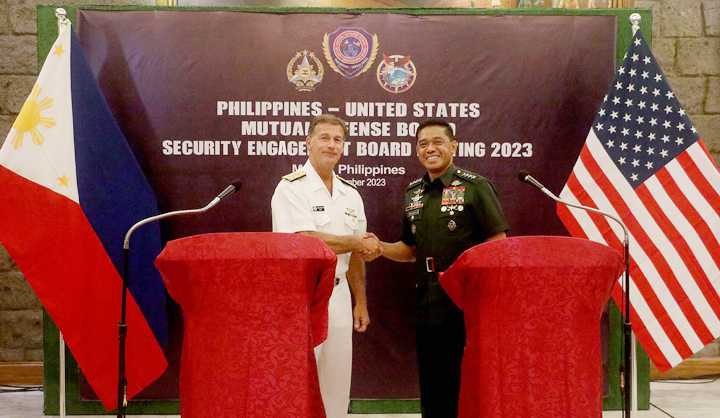
The Philippines and the United States are seriously considering the possibility of increasing the number of Enhanced Defense Cooperation Agreement (EDCA) sites in the country.
This was emphasized by Indo-Pacific Command chief Admiral John Aquilino at a news briefing held for the Mutual Defense Board-Security Board (MDB-SEB) meeting, which was held at Camp Aguinaldo in Quezon City Thursday.
Aquilino said he and Armed Forces of the Philippines (AFP) chief Gen. Romeo Brawner Jr. might make a “recommendation” to their respective senior leaders for consideration.
“General Brawner and I may make [a] recommendations to our senior leaders for the consideration of additional sites but there is still work to do there before we get to that answer,” he said.
“We are in discussions but everyone has a boss and we both have bosses, we’ll have those conversations I think in private and give our bosses some decision space on how they’d like to go forward,” Aquilino explained.
He added that 63 more projects have been added for construction in the approved nine EDCA sites, aside from the 32 allocated earlier.
Aquilino also said that the US has also had an “investment of $110 million to those sites to build capability capacity for the AFP to use everyday and for the United States to fall in on when invited,” he added.
The five initial EDCA sites are the Cesar Basa Air Base in Floridablanca, Pampanga; Fort Magsaysay Military Reservation in Nueva Ecija; Lumbia Airport in Cagayan De Oro; Antonio Bautista Air Base in Puerto Princesa, Palawan; and Benito Ebuen Air Base in Cebu.
The four additional are the Naval Base Camilo Osias in Sta. Ana, Cagayan; Lal-lo Airport in Lal-lo Cagayan; Camp Melchor Dela Cruz in Gamu, Isabela; and Balabac Island in Palawan.
Brawner also clarified that the Philippine government also spend for the development of the EDCA sites as these are located in its existing camps and bases.
“Let me also add that when we talk about EDCA sites, these are [located within] existing Philippine camps or bases, we are just opening this up for shared use with our counterpart with our only ally the United States because we believe that doing certain things together would bring more value, some of these EDCA sites would be designed specifically for joint training,” he added.
“Let me [also] emphasize, however, that while the United States is spending for these EDCA sites through the implementation of several projects, I would like to say that the Philippine government is also spending for these EDCA sites primarily because these are our own camps and we have to maintain our camps, we have to make sure that our camps are livable and of course sustainable,” the AFP chief pointed out.
Meanwhile, Brawner said the successful conduct of this year’s MDB-SEB reaffirmed the steadfast commitment of the Philippines and the United States in safeguarding the country and the Indo-Pacific Region.
“I am pleased to stand before you following the successful conclusion of the MDB-SEB meeting. The meeting was marked by fruitful discussions and strategic collaboration, reaffirming the steadfast commitment of the Philippines and the United States in safeguarding our nation and the Indo-Pacific Region,” he added.
In line with this, the AFP has expressed its commitment to “addressing the dynamic and evolving challenges that confront our nation’s security.”
“Just yesterday [Wednesday], Admiral Aquilino and myself, together with Ambassador [Marykay] Carlson and top Filipino and US military officials visited the EDCA sites in Lal-lo Airport and Naval Base Camilo Osias in Sta. Ana, Cagayan; and Basa Air Base, Pampanga. We conducted an extensive tour of the completed EDCA projects and we were able to gain first-hand knowledge of the bases’ potential for the development of key facilities to support humanitarian assistance and disaster response operations,” Brawner reported.
He said this underscores the continued partnership and collaboration between the Philippines and United States militaries in enhancing national defense capabilities, as well as the shared commitment to regional security and disaster response efforts.
“It signifies our commitment to further strengthen our cooperation, ensuring that both militaries are prepared and well-equipped to respond to evolving security challenges and humanitarian crises,” Brawner concluded.
Image credits: NoNoy Lacza
